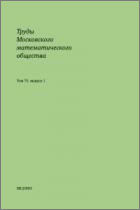|
|
Trudy Moskovskogo Matematicheskogo Obshchestva, 2011, Volume 72, Issue 2, Pages 223–247
(Mi mmo17)
|
 |
|
 |
Quantitative jump theorem
P. I. Kaleda
OJSC NIKIET, Moscow
Abstract:
The jump theorem proved by Mishchenko and Pontryagin more than fifty years ago is one of the fundamental results in the theory of relaxation oscillations. Its statement is asymptotic in character. In this paper we present a quantitative analogue of it. This means the following. The jump theorem describes the map along trajectories (the Poincaré map) from a transversal ‘before the jump’ to a transversal ‘after the jump’. This map is exponentially contracting, and its deviation from the jump point with respect to the slow coordinate is of order
ε2/3, where ε is the small parameter in the fast-slow system. These estimates are asymptotic. Normalizing the system by choosing the scale, we prove that for all ε no greater than
e−12, the Poincaré map is defined, its deviation lies in the interval ε2/3[e−6,e3], and the map itself is a contraction with a coefficient that does not exceed e−k(ε), where
k(ε)⩾1/(6ε)−103. The main tool used in the investigation is the method of blowup with different weights, in the form described by Krupa and Szmolyan.
Key words and phrases:
relaxation oscillations, fast-slow system, jump point, resolution of singularities, normal form.
Received: 13.12.2010
Revised: 21.03.2011
Citation:
P. I. Kaleda, “Quantitative jump theorem”, Tr. Mosk. Mat. Obs., 72, no. 2, MCCME, Moscow, 2011, 223–247; Trans. Moscow Math. Soc., 72 (2011), 171–191
Linking options:
https://www.mathnet.ru/eng/mmo17 https://www.mathnet.ru/eng/mmo/v72/i2/p223
|

| Statistics & downloads: |
| Abstract page: | 195 | | Full-text PDF : | 62 | | References: | 39 |
|




 Contact us:
Contact us: Terms of Use
Terms of Use
 Registration to the website
Registration to the website Logotypes
Logotypes









 Citation in format
Citation in format 